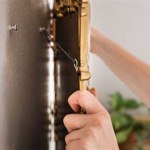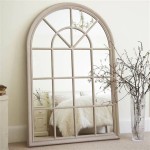Gluing Wood Frame to Mirror
Adding a wood frame to a mirror elevates its aesthetic appeal, transforming a simple reflective surface into a decorative piece. Achieving a professional-looking result requires proper technique, especially when it comes to adhering the frame securely to the mirror. This article outlines the process of gluing a wood frame to a mirror, highlighting key considerations and best practices for a successful and lasting bond.
Choosing the Right Adhesive
Selecting the appropriate adhesive is paramount for a strong and durable bond. Traditional wood glues are unsuitable for this application due to their potential to damage the mirror's silvering. Neutral cure silicone adhesives are generally recommended for their strong adhesion, flexibility, and compatibility with both wood and glass. Opt for a high-quality silicone specifically designed for mirror mounting to ensure optimal performance and longevity.
Preparing the Surfaces
Proper surface preparation is crucial for achieving a secure bond. Both the wood frame and the mirror's edge must be clean and free of any dust, debris, or grease. Clean the wood frame with a damp cloth and allow it to dry completely. Clean the mirror's edge with a glass cleaner and a lint-free cloth, ensuring no residue remains.
Applying the Adhesive
Apply a continuous bead of silicone adhesive to the back inside edge of the wood frame where it will contact the mirror. Avoid applying excessive adhesive, as this can create a mess and potentially seep onto the mirror's surface. A consistent bead ensures even distribution and a strong, uniform bond.
Positioning and Securing the Frame
Carefully position the wood frame onto the mirror, aligning it precisely. Once the frame is in place, apply gentle pressure to ensure good contact between the frame and the mirror. Use masking tape or clamps to hold the frame securely in place while the adhesive cures. Follow the manufacturer's instructions for the recommended curing time, typically 24 to 48 hours.
Supporting the Frame During Curing
While the adhesive cures, it's essential to support the frame evenly to prevent slippage or uneven bonding. Depending on the size and weight of the frame, this can be achieved by using blocks, shims, or other supports placed strategically around the mirror. Ensure these supports do not exert excessive pressure on the frame or the mirror.
Cleaning Excess Adhesive
Once the adhesive has fully cured, carefully remove any excess silicone that may have squeezed out from under the frame. A razor blade or a plastic scraper can be used to remove the cured silicone. Exercise caution to avoid scratching the mirror's surface. Clean any remaining residue with a suitable solvent recommended by the adhesive manufacturer.
Considerations for Different Frame Types
The gluing process may vary slightly depending on the type of wood frame being used. For intricate or heavy frames, additional support may be necessary during the curing process. For frames with mitered corners, ensure tight joints and consider reinforcing the corners with additional adhesive or small brads before attaching the frame to the mirror.
Safety Precautions
When working with adhesives and sharp tools like razor blades, it's crucial to prioritize safety. Wear appropriate safety glasses and gloves to protect your eyes and skin. Work in a well-ventilated area to minimize exposure to adhesive fumes. Dispose of used razor blades and other sharp objects safely.
Choosing the Right Mirror
The type of mirror also plays a role in the success of the gluing process. Ensure the mirror is clean and free of defects. The edges of the mirror should be smooth and even for optimal adhesion. Consider the weight and thickness of the mirror when selecting the appropriate adhesive and framing materials.
Environmental Considerations
Temperature and humidity can affect the curing time and performance of the adhesive. Ideally, the gluing process should be carried out in a room with moderate temperature and humidity levels. Avoid gluing in extremely hot, cold, or damp environments, as these conditions can negatively impact the bond strength.

Mirror Frame Diy How To Update A Basic Bathroom Our Faux Farmhouse

Mirror Frame Diy How To Update A Basic Bathroom Our Faux Farmhouse

Mirror Frame Diy How To Update A Basic Bathroom Our Faux Farmhouse

Diy Stick On Mirror Frame Sawdust Sisters

Diy Bathroom Mirror Frame Without Removing Clips Her Happy Home

Diy Bathroom Mirror Frame For Under 10 O Hayley Blog

Easy Driftwood Mirror The Wood Grain Cottage

How To Make A Simple Mirror Frame With Wood Upgrade An Old

Mirror Frame Diy How To Update A Basic Bathroom Our Faux Farmhouse

Diy Farmhouse Wood Frame Mirror She Gave It A Go








